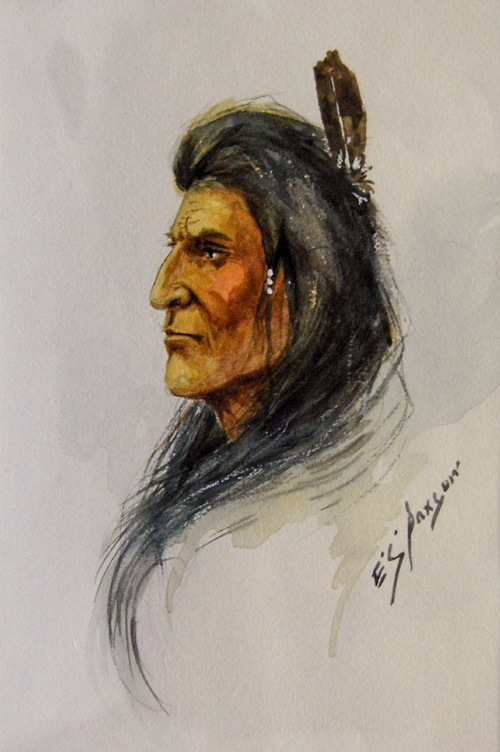When four Cheyennes arrive at Fort Mandan below the Knife River Villages, the captains give them a speech, tobacco, a flag, and demonstrations of many ‘curiosities’. They also give them a letter of warning to deliver to the Sioux and Arikaras.
A Warning for the Sioux
by Yellowstone Public Radio[1]Originally aired weekdays by Yellowstone Public Radio during the Bicentennial observance of 2003-2006. Narrated by Hal Hansen. Scripts by Whit Hansen and Ed Jacobson. Produced by Leni Holliman. © … Continue reading
Cheyenne
Edgar S. Paxson (1852-1919)
Meloy & Paxson Galleries; The University of Montana PARTV Center.
Mandans and Cheyennes
the Chiefs of the Lower village of the Mandans with maney of theire young men and 4 of the Shar-ha’s [Cheyennes] who had come to Smoke with the pipe of Peace with the Mandans, we explained to them our intentions our views and advised them to be at peace, Gave them a flag for theire nation, Some Tobacco with a Speech to Deliver to their nation on theire return
—William Clark
Arikara and Sioux Warnings
also Sent by them a letter to Mrs. Tabbo & Gravoline [Joseph Gravelines], at the Ricares [Arikara] Village, to interseid in proventing Hostilities, and if they Could not effect those measures to Send & informe us of what was going on, Stateing to the Indians the part we intend to take if the Rickores & Seauex [Sioux] did not follow our Derections and be at peace with the nations which we had addopted—
—William Clark
Weather Diary
Ther. at rise
Weather Wind at rise
Thert. at 4 P.M. Weather Wind at 4 P.M. River 38 above fair N W. 36 fair N W raise 1 in. —Meriwether Lewis[2]To assist the reader, the editor of this web page has omitted the date column, merged the “River” columns, and spelled out some abbreviations.
Fort Mandan is a High Potential Historic Site along the Lewis and Clark National Historic Trail managed by the U.S. National Park Service. The North Dakota Department of Parks and Recreation manages a modern reconstruction and the Lewis and Clark Interpretive Center located at US Hwy 83 and ND Hwy 200A.
Knife River Indian Villages National Historic Site is a High Potential Historic Site along the Lewis and Clark National Historic Trail managed by the U.S. National Park Service. A unit of the National Park System, the site is located at 564 County Road 37, one-half mile north of Stanton, North Dakota. It has exhibits, trails, and a visitor center.
Notes
| ↑1 | Originally aired weekdays by Yellowstone Public Radio during the Bicentennial observance of 2003-2006. Narrated by Hal Hansen. Scripts by Whit Hansen and Ed Jacobson. Produced by Leni Holliman. © 2003 by Yellowstone Public Radio. |
|---|---|
| ↑2 | To assist the reader, the editor of this web page has omitted the date column, merged the “River” columns, and spelled out some abbreviations. |
Experience the Lewis and Clark Trail
The Lewis and Clark Trail Experience—our sister site at lewisandclark.travel—connects the world to people and places on the Lewis and Clark Trail.
Discover More
- The Lewis and Clark Expedition: Day by Day by Gary E. Moulton (University of Nebraska Press, 2018). The story in prose, 14 May 1804–23 September 1806.
- The Lewis and Clark Journals: An American Epic of Discovery (abridged) by Gary E. Moulton (University of Nebraska Press, 2003). Selected journal excerpts, 14 May 1804–23 September 1806.
- The Lewis and Clark Journals. by Gary E. Moulton (University of Nebraska Press, 1983–2001). The complete story in 13 volumes.




